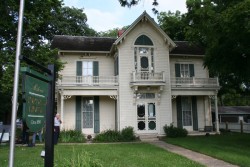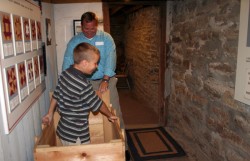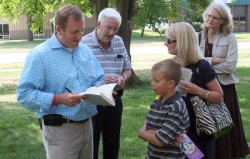 The Jordan House, which is the oldest structure in West Des Moines, is listed on the National Register of Historic Places. |
CONTACT: Tory Olson, 515-271-1834, tory.olson@drake.edu
With Abraham Lincoln and abolition fresh in their minds, students in a Drake University class recently toured West Des Moines’ Jordan House, where many slaves found refuge along the Underground Railroad.
The students visited the historic site as part of a class offered by Drake in conjunction with its new “Citizens Arise! — the Foundations of Democracy” series. The class, “Making Presidential History Come Alive,” will be held through Aug. 14.
Civil War and Abraham Lincoln expert Matthew Pinsker, the Brian Pohanka Chair of Civil War history at Dickinson College in Pennsylvania, accompanied the group as they went through the house.
Among the group was Tom Nahas, 9, of West Des Moines. Pinsker and Nahas talked about what it must have been like for one slave, Henry ‘Box’ Brown, who packed himself into a box to ship himself to a free state.
 Matthew Pinsker asks Tom Nahas what it was like to experience being in a box similar to the one Henry “Box” Brown traveled in during the 1800s. |
“Henry ‘Box’ Brown must have felt lonely in that box, all by himself in the dark,” said Nahas, who climbed inside a simulation box in the cellar of the Jordan House. “But he was probably thinking about having a better life once he got out.”
The tour supplemented Pinsker’s July 22 two-part lecture on “Abraham Lincoln: Private Man, Public Leader” and “Lincoln’s Sanctuary: Abraham Lincoln and the Soldiers’ Home.”
The house, which is a member of the National Underground Railroad Network to Freedom Program, was built by abolitionist James C. Jordan. He was a cattle farmer from Virginia who settled in Iowa and became an Iowa state senator.
Although it went through many phases, the home was always a safe place for fugitive slaves moving through the Underground Railroad during the antebellum period.
 Matthew Pinsker autographs a book and talks to members of the Drake group outside the Jordan House. |
Pinsker’s visit was part of the “Citizens Arise!” series, which will include various speakers and national traveling exhibits on Presidents John Adams and Abraham Lincoln.
The schedule for the later free exhibits, which are made possible by grants from the National Endowment for the Humanities, appears below:
- Oct. 28-Dec. 11 — “John Adams Unbound” traveling exhibit, Cowles Library Reading Room
- Jan. 11, 2010-Feb. 8, 2010 — “Abraham Lincoln: A Man for His Time, A Man for All Times” traveling exhibit, Cowles Library Reading Room
Read more about the series and view a complete list of events online at citizensarise.drake.edu.
For more information on the series, contact Claudia Frazer at 515-271-3776 or claudia.frazer@drake.edu.
More information on the traveling exhibits
“John Adams Unbound” has been organized by the Boston Public Library and the American Library Association Public Programs Office.
Believing that an “ample and well chosen Assortment of Books” could serve both intellectual and political purposes, President John Adams (1735-1826) assembled one of the greatest private libraries in early America. The traveling exhibition is based upon the gallery exhibition of the same name mounted by the Boston Public Library in 2006, the first public display of Adams’ complete 3,500-book collection. The John Adams Library has been on deposit at the Boston Public Library since 1894.
“Abraham Lincoln: A Man of His Time, A Man for All Times” is a national traveling exhibition organized by the Gilder Lehrman Institute of American History, promoting the study and love of American history since 1994.
The Gilder Lehrman Institute of American History Web site includes material on 19th century culture and the Civil War at: http://www.gilderlehrman.org. The Institute also maintains an online journal at:http://www.historynow.org.

